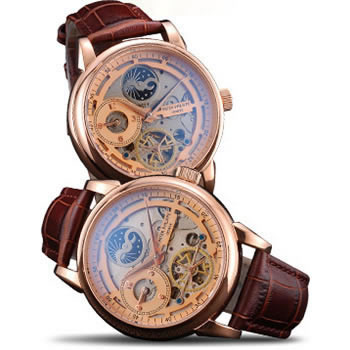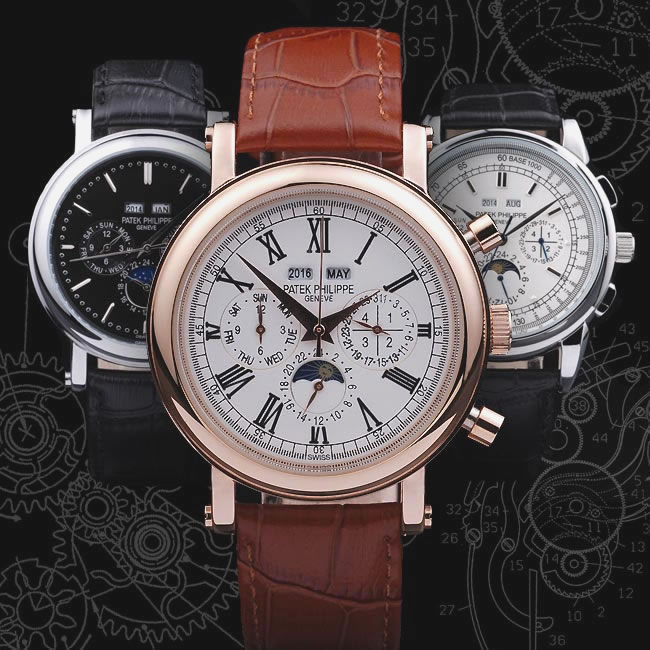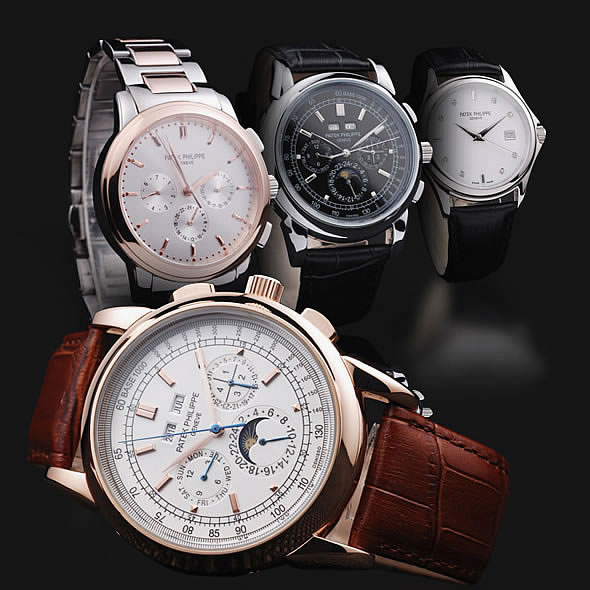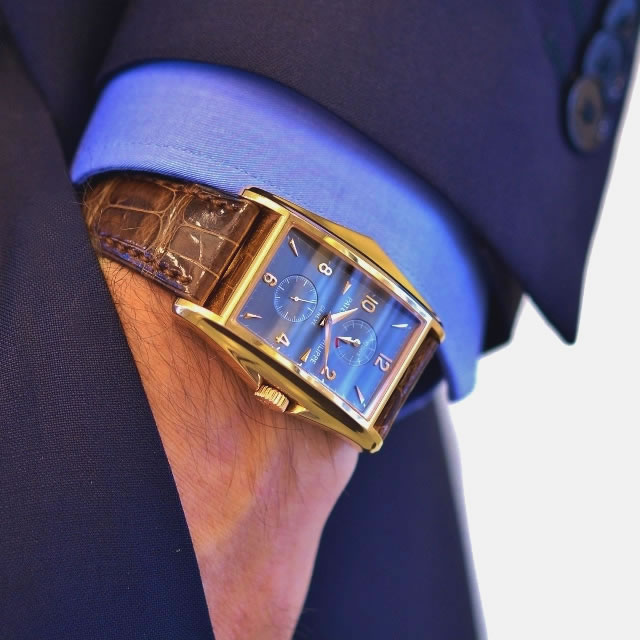
Patek Philippe Dual-Time Moonphase Tourbillon Gold
The movement is an automatic flyback chrono featuring an annual calendar and it had a 24 hour display and an indicator for the power reserve.
Reviews of the best Patek watch Copies and clones
In 2014, the company celebrated its 175th founding anniversary. Let’s take a look at the milestones of Patek Philippe since its inception.

The first ever Patek wristwatch was produced. Its design was quite lavish. It was fitted with the Caliber 27368, a baguette shaped movement that was key-wound. It had 8 jewels and a cylinder escapement. The bracelet and case was yellow gold and the dial had large diamonds and protected by a hinged cover. The sides of the dial also had diamonds. It was delivered to the Countess Koscewicz of Hungary in 1873.
Almost a hundred years ago, some Swiss watch companies made huge watches and one of the pioneers was none other than Patek Philippe. They created a rectangular shaped watch in 1919 that measured 30mm by 43mm. It contained a 12 ligne LeCoultre movement and had a gold case. Patek assigned its movements with quality grades right until the 1930s and the movement of this rectangular timepiece was of the lowest grade. The Patek Philippe Museum in 1989 bought this watch for 55000 Swiss francs.
The very first perpetual calendar wristwatch in the world came about by sheer accident. Patek Philippe originally designed the movement for a women’s pendant watch but after it was completed in 1898, no one was interested of buying it in spite of being equipped with a really unique feature – the calendar hands jumped to the next day instantaneously at the stroke of midnight. The watch remained on the shelf until 1925 and during this time, wristwatches became very popular and this inspired the company to move the movement to a wristwatch case. Two years later it was finally bought.
In 1932, Charles and Jean Stern bought Patek Philippe. They realized that they needed to create something that will be a big hit otherwise they will have a hard time getting the company back on track. So they made Reference 96, a model inspired by Bauhaus which contained the in-house and hand-wound movement caliber 12-120. It measured 4mm high and 26.75mm across. It had a frequency of 18000 vph. The watch’s elegance and simplicity made it a very well-liked timepiece and for decades, the Calatrava became the company’s most popular model.
Beginning 1937, Patek Philippe started using Reference 96 cases for movements that had add-on functions like a calendar with moonphase indicator. The name Calatrava is derived from the longtime logo of Patek, the cross used by the Calatrava Order of the military that was founded in Spain during the Middle Ages. Patek refers to the Calatrava as its signature model.

The Reference 130 was created on September 8, 1934 and it is a much celebrated chronograph. Its movement’s base was an ebauche from Valjoux, a chronograph specialist. The Caliber 23VZ was 5.85mm thick, 13 lignes in diameter and it featured a column wheel. It was introduced in 1916 and Patek during that time reworked the movement so that it would meet the standards of the company. The fourth wheel, escape wheel and driving wheel had separate cocks and the chronograph bridge had a new shape, while the column wheel was equipped with a cap. This movement continued to be used for over 5 decades.
Renowned watchmaker Louis Cottier had several important clients and one of them was Patek Philippe. Cottier made his favorite complicated movement for Patek Philippe and it featured a 24-hour ring that rotated counter clockwise once daily against a bezel that was inscribed with names of cities. The local time would be shown on the display located in the center of the dial and to see any other timezone, the wearer just had to look at the hour numeral located right next to the name of a city which represented a particular timezone. In the year 1937 the company introduced its very first world timer wristwatch that had a stationary bezel. The watch, Reference 515 HU shows GMT at 12 o’clock. In the same year, they unveiled a better version the Reference 542 HU which had a rotating bezel.

White gold or rose gold case with a natural leather strap and black or white dial with roman numerals.

New manually wound Grand Complications for Men and ultra-thin self-winding Calatrava Ladies watches.

Day-Date indicator and 8 day power reserve from a manually wound movement in Art Deco style inspired case.